#yohatsu
Explore tagged Tumblr posts
Note
If a geisha doesn't want to wear a wig, can she tie her hair?
Do you mean Nihongami like Maiko/Hangyoku wear it? I suppose in Hanamachi with less strict rules, it's possible (three Geisha from Oi/Omori in Tokyo, who were active in the late 2000's to late 2010's, wore their own hair in Nihongami frequently). Also Shin Nihongami is possible to create without the help of a Kamiyui, if you're skilled enough. But since I don't have back pictures of those respective Geisha, I don't know what exact hairstyles they wore.

Kyoto Geiko wear Chû shimada/Kyofu shimada done with their own hair for Miyako Odori and Tea ceremony at the other Odori. In this case, if you see a senior Geiko having her own hair styled this way, she chose this over wearing a wig. Junior Geiko don't have this choice. When Odori season is over, they go back to their usual styles of Katsura or Yohatsu.

Yohatsu isn't technically Nihongami, but it's done with your own hair. It's the everyday look for jikata, Geisha who have aged out of Katsura+Oshiroi, or Geisha who live in cities where the combination of Katsura+Oshiroi is only worn for special occasions like the new year, or not at all. Outside of the Hanamachi, it's a popular hairstyle for wearing Kimono. It is also a hairstyle that Geisha can do themselves, although I suppose, at least in Kyoto, they mostly let a professional do the job.

For more casual occasions - like lessons or Miyabi-kai, especially junior Geiko wear a hairstyle more simple than Yohatsu: combed back, or with a side part in a bun (sorry, don't have any pictures available).
25 notes
·
View notes
Note
Do you know if any geiko appeared in the 2024 Jidai matsuri?
Yes, I do! The list is as follows: Tomoe Gozen: Chizu (千鶴) of Pontocho Ono No Komachi: Hidechisa (秀千紗) of Pontocho Murasaki Shikibu: Tamayuki (珠雪) of Pontocho Sei Shonagon: Momifuku (もみ福) of Pontocho Yokobue: Taka (多香) of Pontocho Tokiwa Gozen: Hidechiyo (秀千代) of Pontocho Shizuka Gozen: Masaki (満彩希) of Gion Higashi Shizuka's Attendant: Kanoshizu (叶静) of Gion Higashi Abutsu Ni: Tomieri (富瑛梨) of Gion Higashi Yodogimi: Hinayū (雛佑) of Gion Higashi Yodogimi's Attendants: Kanosono (叶園), Kanosuzu (叶鈴), and Hinaho (雛帆) of Gion Higashi Kanowaka (叶和佳) of Gion Higashi also participated as an attendant in the ceremony, but she was dressed in houmongi and yohatsu and not in a costumed role.
16 notes
·
View notes
Text
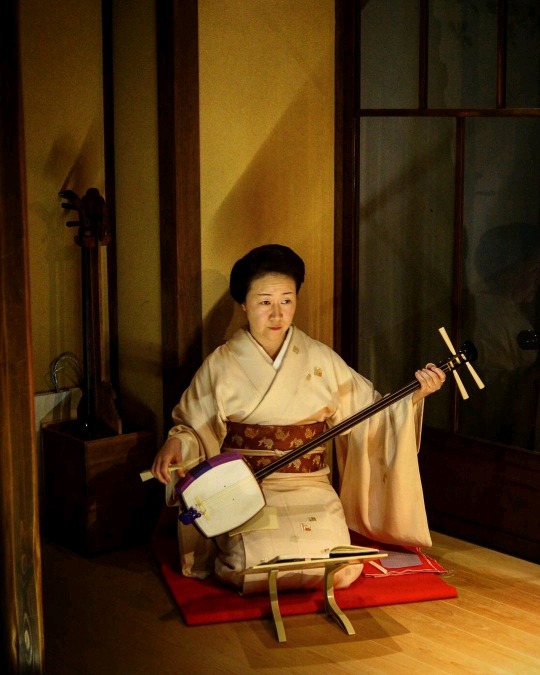
February 2019: Jikata Geiko Ichisumi (Ichi Okiya) of Kamishichiken playing the shamisen and singing at an ozashiki at the Umeno Ochaya.
Ichisumi debuted in September of 2016 directly as a Jikata Geiko, when she was already in her fourties. Her Misedashi was so low-key that, for about a month, I didn’t even know that she was around!
Except for Gion Kobu, all kagai of Kyoto allow women too old to become Maiko to debut directly as tachikata Geiko (dancers); however, the age limit for that is around 30 years old. Jikata Geiko can debut at all ages, there are several more recent example of jikata debuting well into their sixties.
That is not to say that women debuting as Jikata Geiko are simply too old to become tachikata; almost all of them are already proficient in music before entering training and see being a Jikata Geiko as their ideal profession.
Source: Kyoto Insider on Instagram
#ichisumi#ichi okiya#kamishichiken#houmongi kimono#houmongi#kimono#kosode#obi#obiage#obijime#shamisen#yoohatsu hairstyle#yoohatsu#yohatsu hairstyle#yohatsu#hairstyle#hair#nihongami#geisha#geiko#geigi#jikata geiko#jikata#maiko#karyukai#japan#japanese
81 notes
·
View notes
Note
Do you think if a foreigner wanted to chase after the geisha career in Kyoto, would it be allowed? I was asked this question after drawing a maiko piece and I couldn't answer them. Also the person who asked me has long red hair like down to her waist- would they have someone who isn't naturally dark haired dye their hair black or keep it natural?
No, they wouldn’t be able to become a geisha in Kyoto. Kyoto’s hanamachi are very traditional and don’t allow non-Japanese people to join. They could become a geisha in another city though, especially Tokyo, which has had multiple non-Japanese women working as geisha. This person could keep their hair natural. There was a Russian woman (her geimyo was Ibu) working as a geisha a number of years ago and she kept her natural blonde hair. The hair length might be an issue, though. It could be too long to style into yohatsu or tuck under a wig.
15 notes
·
View notes
Text

The look of… IX: Hakone-Yumoto Onsen
History Although it‘s likely that Geisha worked in Hakone since the late 19th century, not much can be found about their history. The current Kenban was built in 1950 [1]. In the early/mid 80's (before the bubble economy), 400-450 Geisha lived in Hakone [2]. The Otosan of Ikedaya Okiya reformed the traditional employment system and introduced benefits like pension plans and financial compensations for cancelled jobs [3].
In 2000 latest, the Hakone Yumoto Kenban launched its own website [4], creating a space for Okiya to advertise and look for new members [5]. In 2001, the Okasan of Wakita became the current head of the Geigi Union. In order to ensure the survival of local Hanamachi culture, the Kenban became open to public in 2008, and the Geisha band Basara (婆娑羅) was founded in 2009. [2]
In the late 2010's, around 150 Geisha from age 18 to 80 lived in 32 Okiya. Lack of work during the Corona pandemic reduced their numbers to 109 in 2021. The amount of Geisha working in Hakone has increased meanwhile, with 140 of them active in January 2024, but still hasn‘t reached its pre-pandemic levels. [2]

The look of Hakone Maiko
Local term: Kirariko きらり妓
※ Hairstyle: own hair, Shimada mage and Hanaogi mage ※ Kanzashi: Kushi, maezashi, non-seasonal hana kanzashi ※ Make up: western make up or light oshiroi, both lips painted from the start ※ Kimono: Furisode mostly without tucks (rarely with sleeve tucks) ※ Eri: white, white with embroidery (red, red/pink) ※ Obi: Koken musubi ※ Obiage: tied and tucked in, red ※ Obijime: red with simple, rectangular Obidome ※ Footwear: white or black Zori

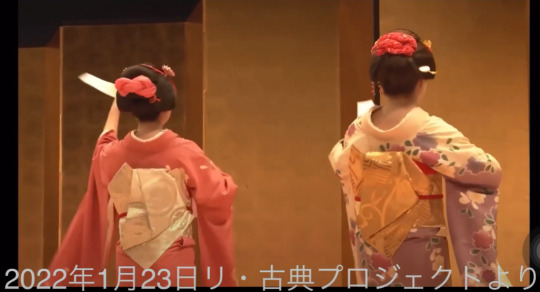
The look of Hakone Geiko
Local term: Geisha
※ Hairstyle: Taka shimada or Tsubushi shimada Katsura ※ Kanzashi: Taka shimada: Kushi, Tama in the back, Kogai in the back, and sometimes in the front too. Tsubushi shimada: Kushi, Tama ※ Make up: Oshiroi ※ Kimono: Mostly Homongi/Tsukesage, sometimes Hikizuri. Kuromontsuki for Tachikata is always a Hikizuri ※ Eri: white, rarely with white or pink embriodery ※ Obi: Yanagi musubi with Kuromontsuki (white/blue Hakata ori), otherwise Otaiko musubi ※ Obiage: always red with Kuromontsuki, otherwise white, pink or light blue. Usually not patterned. ※ Obijime: light-coloured. No Obijime with Yanagi musubi ※ Footwear: Zori, Geta with white or blue Hanao

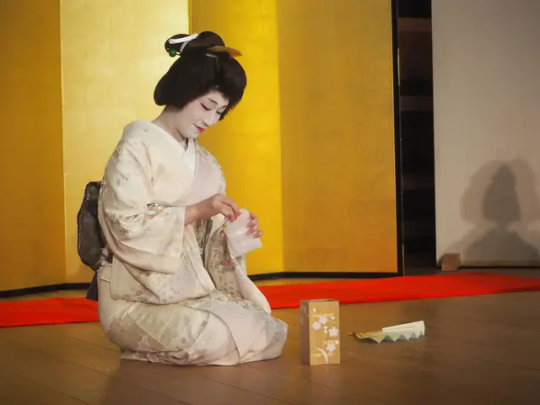
Casual/Jikata style
※ Hairstyle: Yohatsu ※ Kanzashi: usually none, maki (蒔絵) kanzashi at best ※ Make up: western make up ※ Kimono: Kurotomesode, otherwise Homongi ※ Eri: white ※ Obi: Otaiko musubi ※ Obiage: mostly warm pastel colours, but basically anything goes. Not patterned. ※ Obijime: Sometimes with Obidome ※ Footwear: Zôri



Tachiyaku style
※ Hairstyle: Maeware Katsura ※ Kanzashi: Tama pin in the back ※ Make up: Oshiroi ※ Kimono: Hômongi ※ Eri: white ※ Obi: Koken musubi with mint/light green Kakae Obi (抱え帯) ※ Obiage: red, white, pink or light blue. Obidome not uncommon ※ Obijime: light-coloured
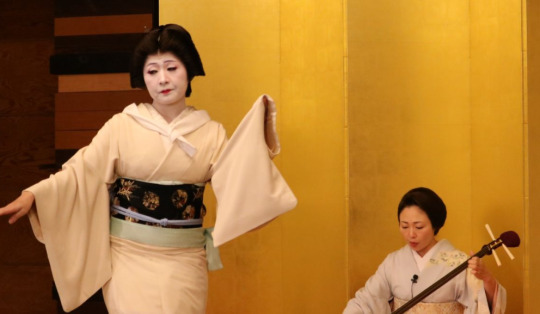
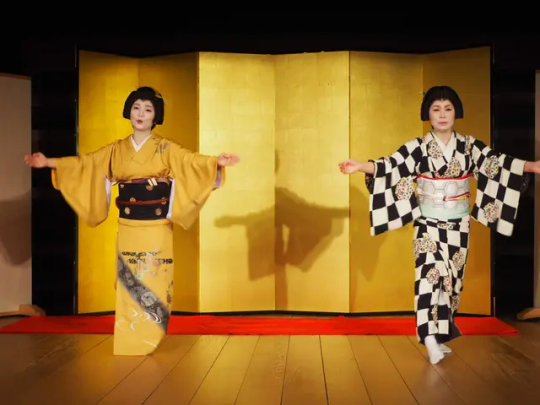
Notes
Arts: The schools taught in Hakone are Nishikawa 西川 (dance), Honjo 本條 (Kouta, Hauta and Min‘yo), Kineya 杵屋 (Nagauta) and Tosha 藤舎 (Hayashi). [6]
Kirariko is a newly coined term in use since 2003 to call junior Geisha in the age group from 18-30. [7] Upon turning 30, Kirariko have to take either a „dancer grade B“ or „dancer grade A“ test. To pass the B test, she has to perform two dances. For the grade A test, she has to perform three female style and three male style dances. [8]
Companions: Okiya recruit and employ companions as well as Geisha. Companions receive a fixed wage, which is usually lower than that of the Geisha, but the customer pays the same price. Companions can be requested to wear either western clothing or Kimono. Western clothing is a business suit provided for free by the Okiya, Kimono can be rented for a set fee by the Okiya as well. [9] Companions receive professional names like Geisha. They don‘t study performing arts and can work part-time. Their job is to serve drinks and food and engage in „pleasant conversation“ with customers at banquets. [10] In my opinion, a good entry-level job in the Karyukai – some companions became Geisha later in their carreer. [11]
Becoming independent: after being Geisha for seven years, you have the opportunity of opening a branch of your debut Okiya. In all cases I know, the new Okiya takes one or two characters from the original Okiya. For example Ikedaya 池田家 → Wakita 和喜田 and Yukieda 雪江田 (田 Kanji is part of the new name). Wakita 和喜田 → Suzuwa すず和 and Yukiwa ゆき和 (和). Kitami 㐂田見 → Kisaya 㐂茶家 (㐂).
Changing Okiya registration: only possible when becoming independent, or when your (biological) mother, sister, or daughter opens a new Okiya.
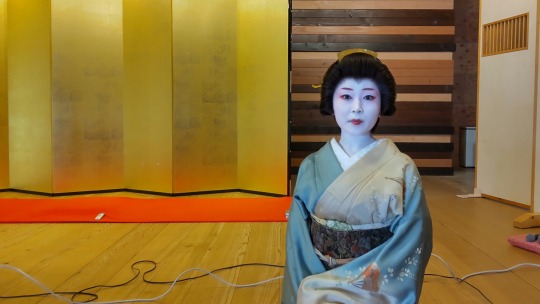
Sources
[1] https://note.com/meetgeisha/n/n1cc907ffd4c9. [2] https://www.tokyo-np.co.jp/article/301712, [3] https://conex-eco.co.jp/hakonesaisai/71824/ [4] https://web.archive.org/web/20000919171055/http://www.geisha.co.jp:80/ [5] https://web.archive.org/web/20001017234326/http://www.geisha.co.jp/okiya-name.htm,[6] https://geisha.co.jp/kenban/, [7] https://web.archive.org/web/20040408030159/http://www11.plala.or.jp/fukunoya/what_is_kirariko.html,[8] https://konohanasakuya.blogspot.com/2012/03/dance-performance.html,[9] https://yukieda.com/kyuujin_answer/, [10] https://yukieda.com/recruit/companion/,[11] https://web.archive.org/web/20080220191156/http://www.00wakita.com/hyousyou.html

Picture sources: Group picture 2024, Hakone Odori, three Kirariko 2023, Kirariko back view 2023, Geisha dancing, Geisha preparing Tosenkyo set 2019, Sumomo with a dancer 2009, Anzu and Yuho 2023, really nice picture of Yumiko with Kokyu 2022, Chacha dancing 2022, Atsumi and unknown Tachikata 2019, Natsumi 2022, Matsuyoshi new year's picture 2023
69 notes
·
View notes
Text
The look of... VIII: Shimizu 清水
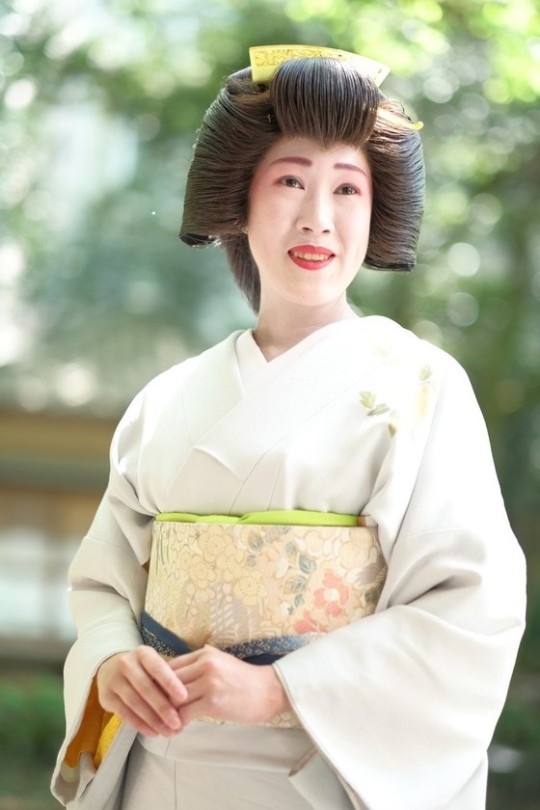
Historical context The first official date in the history of Shimizu Geigi is 1872, when "Machi Geisha" (まち芸者), who were distinct from "Kaku Geisha" (廓芸者), appeared. A Kenban (registry office) was established in 1877. At that time, Machi Geisha and Kaku Geisha combined were around twenty people. Only ten years later, in 1887, their number had increased to 100. The number of Geigi continued to grow.
In 1938, the number of Geigi was around 260, and they were highly regarded nationwide for their skills in art and behaviour. In 1951, a "Shimizu Geigi school" (清水芸妓学校) was opened, around 150 Geigi attending the event.
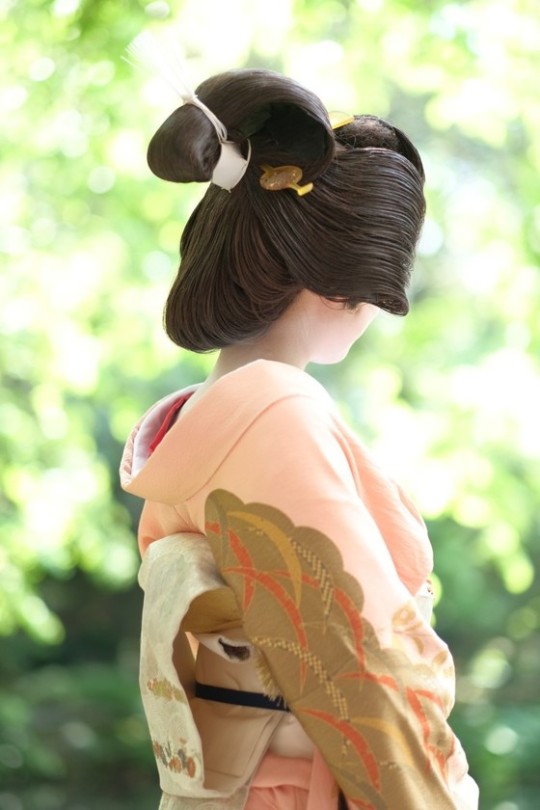
In the 1970's, Japan's period of economic growth started tapering off, interest in traditional arts dwindeled, which resulted in less work opportunities for Geigi and the number of Ryotei decreasing. In response to this, local business leaders and Shimizu Geigi started an organisation to help fostering new Geigi (Seibikai 清美会).
By 1985, their number had decreased to thirteen and the Kenban closed. In 1991, local businessmen and Geigi formed a different company (Seibi Co. 清美(株)), which worked as employer for Geigi. Due to a bad economic environment, Shimizu Odori (清水をどり) was last held in 1998, Seibi Co. was dissolved in 2004, and Haru no mai (春の舞) was discontinued in 2009. As a result of this, some of Seibi's employees became independent Geigi.
Allegedly, the number of Geigi hit rock bottom in 2011 with only two remaining. However, in 2012, around eleven Geigi worked in Shimizu. Since then, the city had a steady stream of Geigi coming and going again. At the end of this year, 2023, there are ten Geigi working in the city.
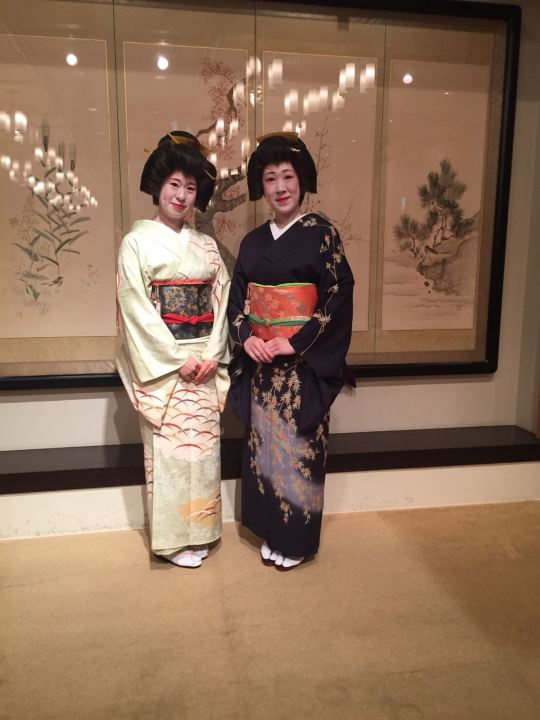
The look of Shimizu Geiko Local Term: Geigi 芸妓 ※ Hairstyle: Taka shimada, Tsubushi shimada ※ Kanzashi: Kushi, Maezashi, bekko kogai, ear of rice in the new year period ※ Kimono: Homongi, Kuromontsuki Hikizuri ※ Haneri: white ※ Obi: Taiko musubi ※ Obiage: green, pink, white, red ※ Obijime: flat, 1 knot ※ Footwear: Zori

Casual look ※ Hairstyle: Yohatsu ※ Kanzashi: none ※ Kimono: Homongi, rarely Komon ※ Haneri: white ※ Obi: Taiko musubi ※ Obiage: white, pink ※ Footwear: Zori

The look of Shimizu Maiko Local term: Shinjin Geigi 新人芸妓 ※ Hairstyle: Momoware Katsura, sometimes real hair styled (shin nihongami) ※ Kanzashi: seasonal and non-seasonal Hanakanzashi, Katsuyama, maezashi, Shidare in all age groups ※ Kimono: Furisode with shoulder tucks or no tucks at all ※ Eri: white with white embroidery, plain white, white with multicolour embroidery, other colours possible especially during summer months ※ Obi: Koken musubi ※ Obiage: flat, mostly red/silver, red/white shibori, other colours also possible (green/beige/light blue) ※ Obijime: flat or round with 1-4 knots. No obidome ※ Footwear: Zôri

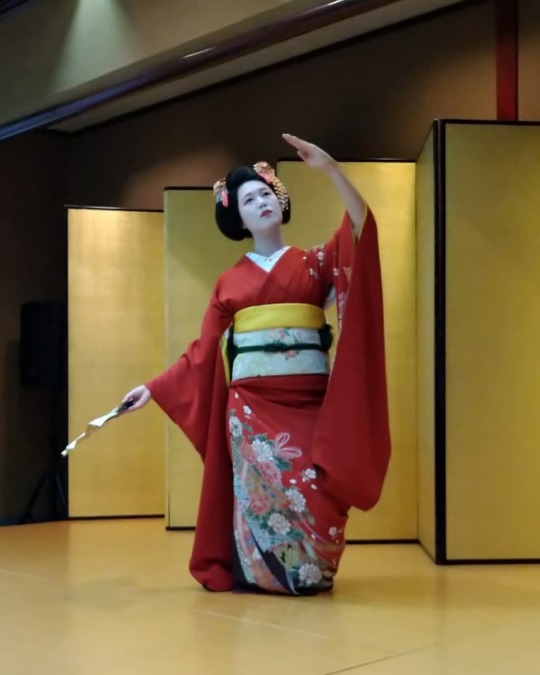
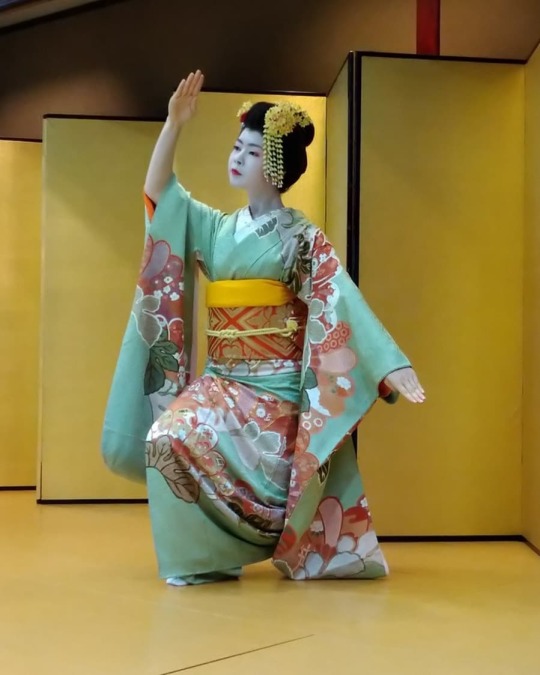
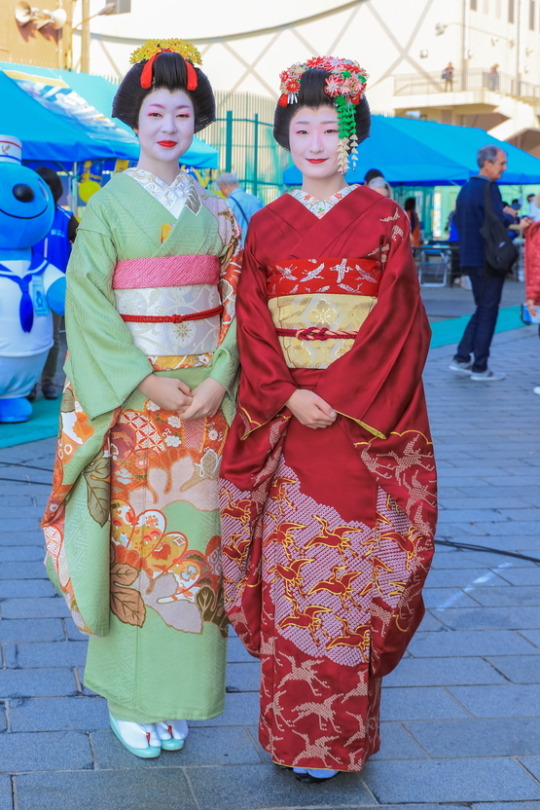
Notes Shimizu was merged with Shizuoka in 2003. Shimizu Geigi and other traditional arts performers are backed by 静岡伝統芸能振興 Shizuoka dentô geinô Shinkô-kai/Shizuoka traditional performing arts promotion association, which is the successor to Seibikai. You might notice I didn't start this post with a historical b/w photo. There are some old photos on the Shizuoka Dentogeino homepage, but they are the size of a postal stamp. And that's it. I feel let down. No chance to explore the historical style of Shimizu. Anyways. "The look of Shimizu/Shizuoka" was requested by @geimaiko. The layout of this post is based on geimaiko's own. Also... geimaiko originally started these series. If you liked this post, you should go and thank her, because without her, there would be no "the look of..." ;)
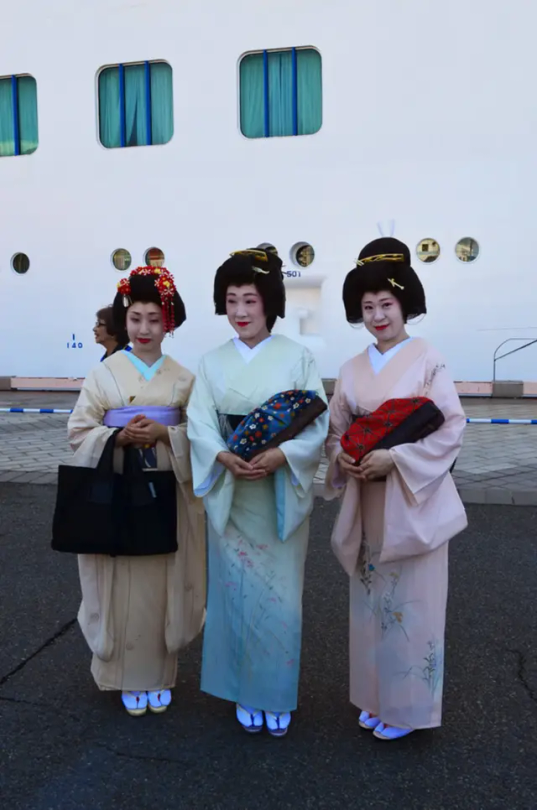

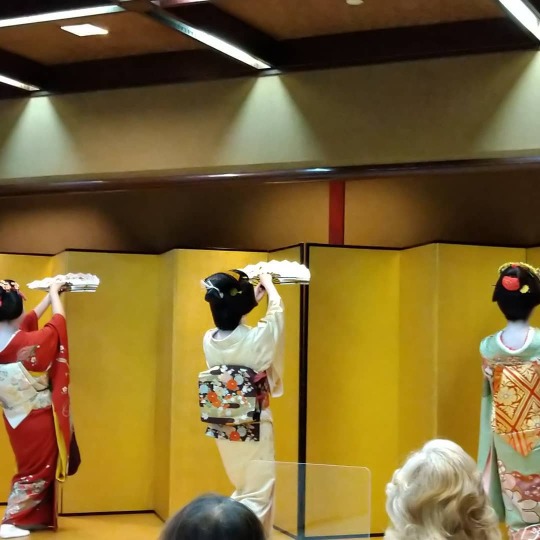
Sources https://www.shizuoka-dentogeino.jp/geigi/shizuoka_history/, https://www.shizuoka-dentogeino.jp/geigi/shimizu_history/, http://www.shimizu-port.jp/geigi.html, https://www.nikkei.com/article/DGXNZO41971500Z20C12A5L61000/ (headline and preview only), https://www.youtube.com/@shizuokadentogeino/videos
Pictures: Komachi May 17, Makoto May 17, Komachi+Makoto Oct 17 (sources nowhere to be found), Sakurako+Fukutaro Apr 22, Kikuno+Umeka Nov 14, Iroha Jun 20, Iroha Oct 20, Fukutaro Oct 20, Ichiryo+Komachi+Makoto ~2016, Komachi+Sakurako Apr 18, Fukutaro+Sakurako Oct 18, Iroha+Fukutaro+Sakurako Oct 20
#mg#geisha#geiko#maiko#hangyoku#geigi#shizuoka#kimono#komachi#makoto#sakurako#fukutaro#kikuno#umeka#iroha
117 notes
·
View notes
Note
What is the Yohatsu hairstyle? Did older women wear their hair in Yohatsu? Does hair have to be very short for Yohatsu Hairstyle?
Yohatsu simply means "Western Style" and was modeled (loosely) after hairstyles that Western women were wearing in the early 20th century. It wasn't for older women so much as it was for mature (re: married) women. The hair still has to have some length to it in order to be styled in yohatsu and can't be cut short to achieve the proper look ^^
10 notes
·
View notes
Note
hi! i’ve heard that in tokyo, the geisha district kagurazaka is open to taking foreigners (i believe). if that is true, how would that necessarily happen? and how would it work? like certain hair types. for example, lets use me! i am a african american person who is light skin with curly hair. how would they make my hair into the way maiko have theirs? use a wig? get a lace front? etc etc.
Hey! I can't confirm that, only know that the Kagurazaka Geisha Union is open for new Geisha/Hangyoku recruits. You asked about the hair: The wigs ("Katsura") worn by Hangyoku or Geisha look like this (example of one specific hairstyle, but the structure is the same with all wigs): https://azuma-online.shop/?pid=178657614 Hangyoku's hair is usually not much longer than shoulder/scapula length, and for Geisha, even shorter works for Yohatsu, but a bob might be too short (Yohatsu uses hair padding, but as far as I know, no extensions - Azusa mentions here her hair is shorter than ever and she might have gone too far with cutting it). All nine "foreign Geisha" I know of (starting from 2009) have/had straight hair. I'm not a hairdresser and don't have any experience with curly hair, but I don't see why Nihongami wouldn't work if you don't have straight hair, as long as it's long enough. Let me link you some examples, so you can see for yourself how Nihongami works, and if it would be possible for you: 1. Some modern Nihongami with simple tools and no extensions on a wig head: https://www.youtube.com/watch?v=sNOH4wmVz1o 2. Tsubushi shimada on an actual person with extensions and hair padding, I think this is pretty close to the way Maiko/Hangyoku get their hair done: https://www.youtube.com/watch?v=QpBIX4YQBTo 3. Wareshinobu and Ofuku Kyo Maiko style: https://www.youtube.com/watch?v=PVoZSOS-wrQ Hope this helps!
23 notes
·
View notes
Text
The look of... VII: Mukojima
Welcome to the 18th installment of this series (my 7th). This time, we’re having a look at the Geigi that work in one of Tokyo's Hanamachi: Mukojima (向島).

Historical context Geisha started to live in Mukojima in the early Meiji period (1868-1912) [1]. From the Edo to Meiji period, Mukojima was a recreational area for the common people, and was frequented by Yanagibashi and Yoshiwara Geisha with their customers. [3] The earliest record of a Mukojima Geisha (known to me) is Omomo お百, who was featured in "Contemporary Beauties", 1897 [2]. In 1906, 30 Geisha lived in the area. By 1928, their number had increased to 239. In 1940, several Kenban united, further increasing the number of Mukojima Geisha to 1300. Like in all Hanamachi around Japan, their number declined steadily after the second world war. In 1951, their number was 600, in 1993 240 [7], in 1996 170, in 2007 120 [3], in 2020 around 90 [4]. This makes Mukojima approximately as populated as Gion Kobu and Tokyo's largest Hanamachi.

The look of Mukojima Geiko. Local Term: Geisha 芸者 ※ Hairstyle: Taka shimada, Tsubushi shimada ※ Kanzashi: Kushi, Maezashi, Hirauchi or Tama in the back, rice husk in the new year period ※ Makeup: Oshiroi ※ Kimono: everyday Kimono: Homongi. Kuromontsuki Hikizuri mostly in the new year period or for Erikae, rarely non-black Hikizuri. ※ Haneri: white ※ Obi: Taiko musubi, Yanagi musubi with Kuromontsuki Hikizuri, Tsunodashi musubi with other Hikizuri ※ Obijime: mostly light-coloured. No obijime with yanagi musubi ※ Obiage: mostly red, pink, or white. Seldomly turquoise, white/green, white with red shibori (red/red-white shibori with Kuromontsuki) ※ Footwear: mostly Zori, also Geta

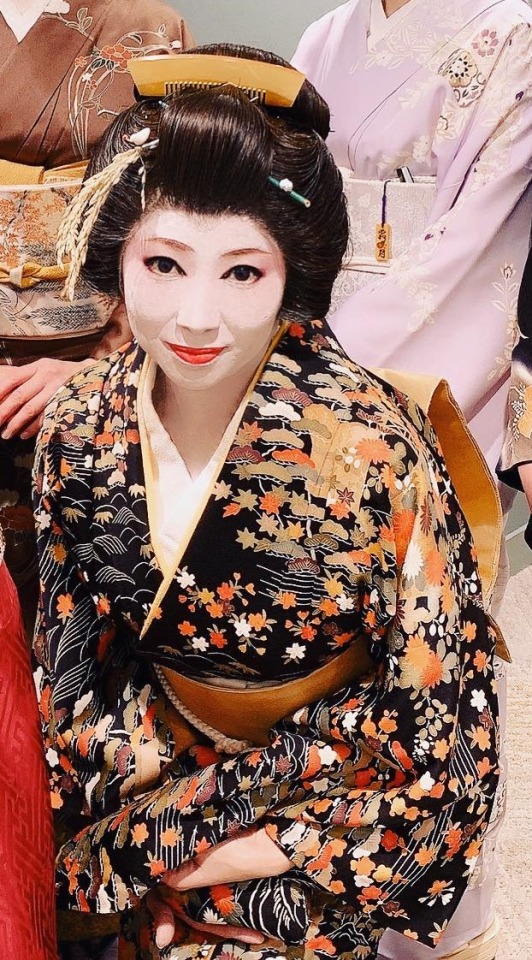


Casual/Jikata look ※ Hairstyle: Yohatsu ※ Kanzashi: none ※ Makeup: western makeup ※ Kimono: Homongi, Kurotomesode ※ Eri: white ※ Obi: Taiko musubi ※ Obijime: mostly light-coloured. In rare cases with pocchiri ※ Obiage: white with red shibori, pink, white, pink/turquoise ※ Footwear: Zori
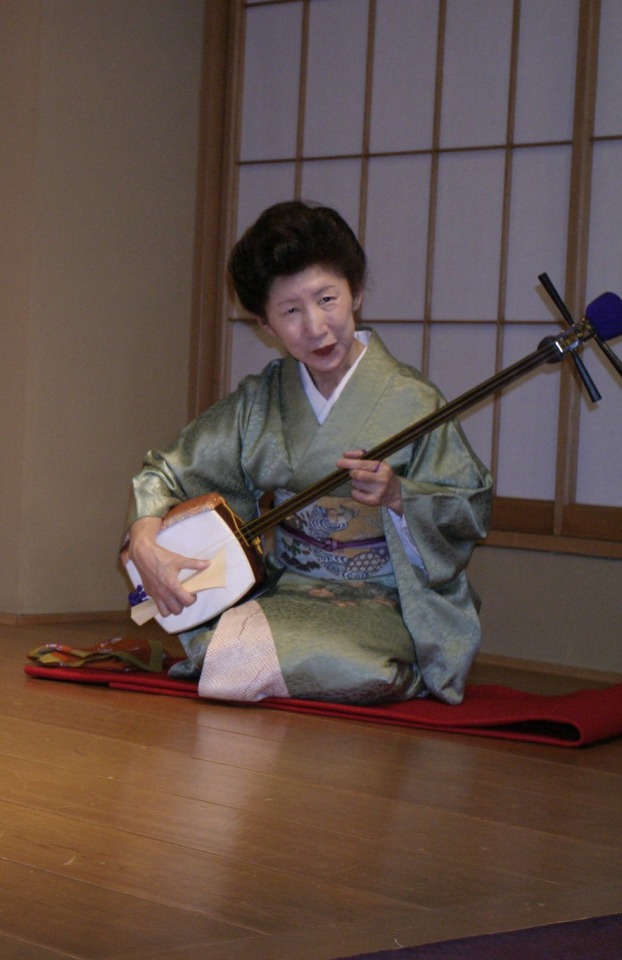


The look of Mukojima Maiko. Local term: Hangyoku 半玉 ※ Hairstyle: Momoware (own hair or wig), Yuiwata for senior Hangyoku (only wig). Shibori, Kanoko and Chinkoro are mostly red, but can also be pink during summer. ※ Kanzashi: seasonal flower kanzashi (1-2 Daikan, Katsuyama, 1-2 Bira-Ôgi, Shidare popular during the entire apprenticeship), Maezashi (optional), Hirauchi. Minimal flower kanzashi with Yuiwata. ※ Makeup: Oshiroi, both lips painted from the start ※ Kimono: Furisode with or without tucks (all variations possible) ※ Eri: mostly white or red/white. But also pink/red, red/purple/green on white base, pink, green, black/pink/white, etc., etc. ※ Obi: kôken musubi ※ Obijime: light-coloured. sometimes with pocchiri ※ Obiage: most common colour variations are red/silver, or red/white shibori. But there are many other combinations. ※ Footwear: mostly Okobo (with red or pink straps), Zori
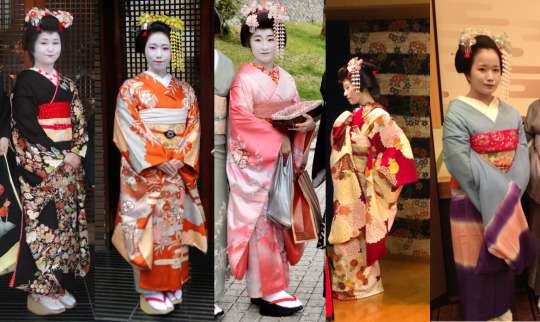
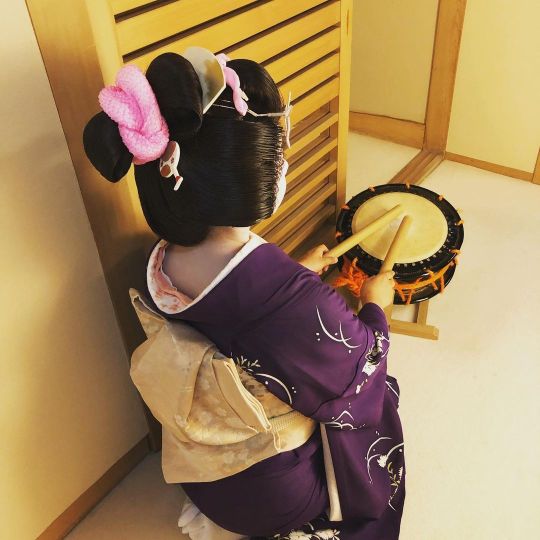



Dances [6] Some dances that are local speciality of Mukojima: ※ Asazuma bune かさずまぶね ※ Fuji musume 藤娘 ※ Fukagawa Kuzushi 深川くずし ※ Gorô ごろう ※ Mukojima ondo 向島音頭 ※ O-Sumio お角��� ※ Otemoyan おてもやん ※ Sôran bushi ソーラン節 ※ Yosakuraya 夜桜や
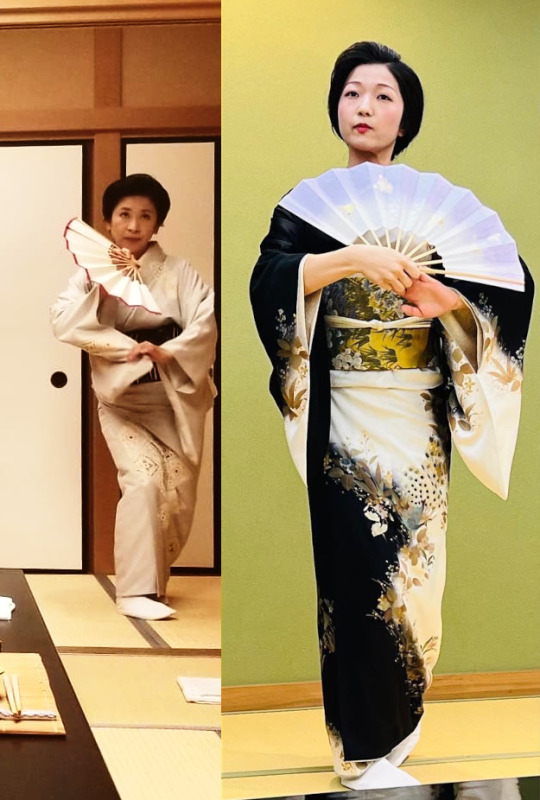
Others that you can also see in Ozashiki outside of Mukojima: ※ Ayame Yukata 菖蒲浴衣 ※ Echigo Jishi 越後獅子 ※ Hanami Odori 花見踊り ※ Hatsuharu 初春 ※ Ina bushi 伊那節 ※ Kiyari Kuzushi 木遣りくずし ※ Sawagi さわぎ ※ Setsuhonkaina せつほんかいな ※ Shichi fukujin 七福神 ※ Takeda bushi 武田節 ※ Tatsumi no hidarizuma 辰巳の左褄 ※ Tsurukame 鶴亀 ※ Yakkosan 奴さん ※ Yoshiwara Suzume 吉原すずめ
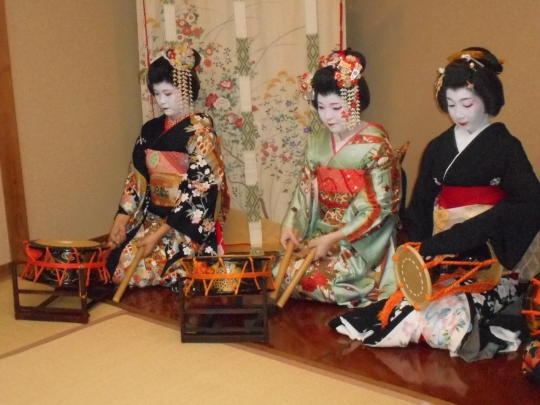
Notes Mukojima allows part-time workers, calling them Kamome かもめ [5]. Most of them are students or work in a different job already. Their task is mainly assisting Geisha/Hangyoku in the Ozashiki. Kamome can become Hangyoku or Geisha if they wish to work full-time. Mukojima dancers also play instruments at ozashiki: Hangyoku frequently play shime-daiko, Tachikata more often play ko-tsutsumi, sometimes fue. Shamisen seems so be reserved for Jikata.
Usually, Ryotei and Okiya are separate businesses in Tokyo. In Mukojima, however, several Ryotei also function as Okiya [3], similar to how in Kyoto, several Ochaya also have an attached Okiya.

Sources - Text [1] Foreign Press Center Japan, Mukojima Press Tour April 2006 https://fpcj.jp/en/assistance-en/tours_notice-en/p=6744/ [2] https://www.flickr.com/photos/blue_ruin_1/28442353867/ [3] numbers 1906-1951, 1996-2007: Sumi Asahara "Tokyo Rokkagai", 2007 [4] not an exact number (account required) https://www.tapatalk.com/groups/tsurukomaiko/hanamachi-population-reference-wip-t2000.html [5] Kamome http://sengoku-japan.com/ [6] dances compiled at Tsurukomaiko, it's by no means a complete list (account required) https://www.tapatalk.com/groups/tsurukomaiko/list-of-dances-in-all-hanamachi-t1988.html [7] 1993: Tsuiseki (追跡): The World of the Geisha, ca. 1993 https://www.youtube.com/watch?v=bkhRWNDwTyM Sources - Pictures Omomo ※ Kingyo Ozashiki ※ Momoka ※ Komachi ※ Yuki+Otokichi ※ Chikage ※ Senyume ※ Hiroya ※ Chikage+Natsuki ※ Tamaki ※ Shingetsu ※ Natsuki (twitter) ※ Soraka (insta) ※ Tomoka ※ Kingyo (fb) ※ Teruka 2x ※ Kanzashi ※ Kintaro (insta) ※ Ayame ※ Kingyo+Rin Ozashiki (fb) ※ Sakura matsuri 2023 I tried to trace back all pictures. If you find the missing links, let me know. "The look of" other Hanamachi: Yamagata, Tokyo Yoshicho, Niigata, Atami, Gifu, Tokyo Kagurazaka, Arima Onsen, Tokyo Asakua, Nagoya, Tokyo Shinbashi, Anjo I Osaka Kitashinchi, II Tokyo Akasaka, III Osaka Nanchi, Fukuoka, V Yuzawa, VI Morioka More Mukojima content: https://maigeiko.tumblr.com/tagged/mukojima Layout: @geimaiko, thanks as always! ♥
73 notes
·
View notes
Note
is it necessary for a geiko to dress formally to an ozashiki or can they not wear the wig and paint their face? If they dont can they only accompany on the shamisen?
They can dress in houmongi with yohatsu if it's requested by the customer. In most cases senior geiko will only entertain this way and will only dress with oshiroi if requested by a special customer. When dressing without oshiroi they can both dance and sing without issue ^^
7 notes
·
View notes
Note
If a foreigner were to become a Geisha, what challenges would she face that other Japanese Geisha may not face? Can be in Tokyo, Kyoto…
I think the most obvious challenges are:
- language: even if you're fluent in Japanese, some Karyukai require their Geisha to learn local dialect
- rejection just because you're a foreigner (one of the former foreign Geisha stated that she was rejected in the city she first applied in, because the kenban deemed their customers to be uninterested in gaijin. She later said that when she got to work as Geisha, people wouldn't take her seriously when wearing the casual Yohatsu/Homongi outfit, and that Katsura/Oshiroi didn't look very flattering on her face, which also didn't help.
- social norms and hierarchy: the hierarchies in the Karyukai are already unusual for Japanese girls, then how alien must it be if you grew up in a different culture?
8 notes
·
View notes
Note
Hi! What is the clothing style of okaa-san? Do they wear a particular style of kimono, hairstyle and makeup?
It's very similar to that of a "casual" geiko; which is to say, it's yohatsu, light make up, and houmongi ^^
5 notes
·
View notes
Text
Kamisuwa Onsen, collected random infos
Back in March, a reader of this blog asked for a blog entry in the vein of previous "the look of..." features, but for Kamisuwa Onsen 上諏訪温泉. Sadly, there isn't much visual material available and the basic look of the 3 or less remaining Geisha boils down to: Yohatsu, Homongi, light-coloured Obiage, Otaiko Musubi, or the formal look: Tsubushi Shimada, Kurotomesode, red Obiage, Otaiko Musubi. So here, I present some collected random infos you might find interesting.
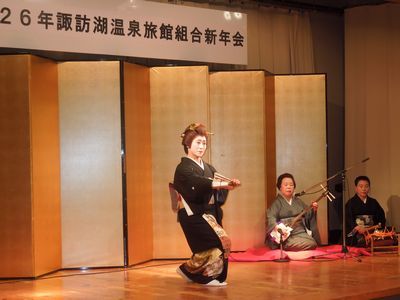
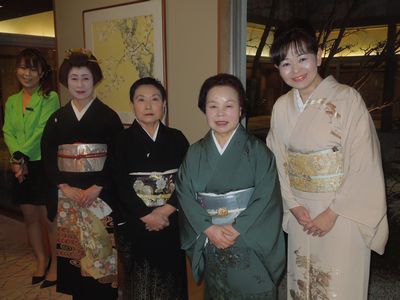
Kamisuwa Geisha, Setsubun 2014
Dances Kappore かっぽれ Takeda bushi 武田節 Kiso bushi 木曽節 Kohan bushi 湖畔節 Ina bushi 伊奈節 Shôchikubai 松竹梅 (performed in the new year season) Tsurukame 鶴亀 (performed at wedding receptions and birthdays) O-Suwa Takashi お諏訪節 Sukêto bushi スケート節 (Ice skating on lake Suwa) Kirigamine kouta 霧ヶ峰小唄 (ice skating) Onhashira kouta 御柱小唄 Suwa ondo 諏訪音頭 (about the beauty of Suwa throughout the seasons) Okaya kouta 岡谷小唄 (about the Okaya silk industry) Numbers 1930's ("early Showa period"): 200 Geisha in Kamisuwa 1958: 80 1960's: 300 2006: 3 History The first Hanamachi on lake Suwa developed in Nawatemachi 縄手町/畷町 in 1903 (renamed to Otemachi 大手町 in 1909). In the following years, a few Ryotei were established. In 1920, the area of Otemachi 1 and 2 chôme was designated as area for Geisha, so Okiya and Ryotei of the neighbouring Izumichô area 和泉町 were moved there. In the early Showa period (1920's/30's), Okiya that were formerly located in Hamamachi also moved to Otemachi. Kamisuwa had two kenban: Ote kenban 大手見番 and Koyanagi kenban 湖柳見番. In Shimosuwa 下諏訪, it seems kenban had no specific names. In Okaya 岡谷, there used to be another Koyanagi kenban 小柳見番 in the Honmachi area. In Chino 茅野, there were Miyagawa kenban 宮川見番 (current Miyagawacho area), and Eimei kenban 永明見番 (current Nakacho area). Before the around 1969/70, Geisha of these respective cities did not work in other cities. But with the decline of Geisha numbers, the Hanamachi in Okaya, Shimosuwa and Chino were no longer able to meet the demands of their customers, so it was allowed for Geisha from Kamisuwa to pad those numbers.
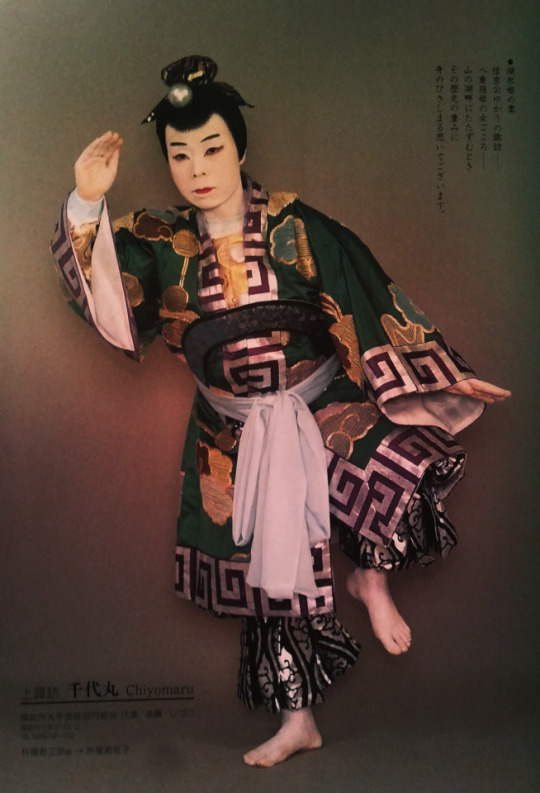
Chiyomaru 千代丸 in "Showa Meigiren", 1988 Daily life Geisha usually practiced their respective arts (such as Narimono, Nagauta, Kouta, dance) until 15:00, afterwards they went to the beauty parlour to get their hair done, put on makeup and change into work clothes. Ozashiki usually lasted for two hours. Style In the year 1935, Geisha still wore their natural hair instead of wigs, and their hairstyle changed, depending on rank and age. Hangyoku wore Momoware 桃割れ and Oshidori おしどり. Geisha under 26 years wore Yuiwata 結い綿 or Taka shimada 高島田, no info on Geisha between 26 and 30, Geisha aged 31 and above wore Geiko yui 芸こ結い, tsubushi (shimada?) つぶし, icho gaeshi 銀杏返, and yokai maki 夜会まき. Around 1955, most Geisha wore short hair or western updos on a daily base and used Nihongami wigs for work. Becoming Geiko Three mediators who acted as go-between of Okiya and families/volunteers worked in Kamisuwa. According to Manchiyo, who worked from 1930 to 44 in Otemachi, the daughters of poor farmers and travelling entertainers were sold to the Okiya for 15 yen. When the parents met with the Okiya, the length of the girl's service was decided. After becoming employed by the Okiya, the girls were doing "odd jobs", while taking lessons in Hanayagi-ryu dance, Shamisen and other arts. It's like Shikomi in Kyoto, although no specific term is named. When a Hangyoku was ready to become a Geisha, she had to prove her skills in dance or shamisen to a council of dance/shamisen teacher, Okiya owner, senior Geisha, head of the Geisha association and a member of the Kenban. The Okiya spent around 30 yen for an Erikae, while the Geisha had to take a loan of 150-200 yen. If her parents were to borrow money during her time before becoming independent, it was added to her loan. If parents continued to ask for money and the Geisha's debt became too large, they often became prostitutes in order to pay off their debts. Around 2 years after becoming Geisha, they became "Goshugi tori" ご祝儀取り - they receive some of the money from the Gyokudai, but tips were entirely for them to keep. The next level was called "share" 分け, when 40% of all earnings were her own. When becoming independent from their Okiya, they paid fees for food and being registered at the place. Most Geisha also had a patron after becoming independent, which also lead to most of them retiring before the age of 30. @gardengeisha yes, this is about Kamisuwa Onsen located in Suwa-gun in Nagano prefecture!
Sources: https://www.saginoyu.com/blog/10090 (2014) 地方花柳界における〈芸〉と〈色〉諏訪湖沿岸 地域の事例 (2015) 花街文化伝える学校が開校/長野・上諏訪温泉 (2008) はなあかり: 昭和名妓連 (1988)
42 notes
·
View notes
Note
Hi! I always see photos of older geiko (maybe) at ozashikis without their hair or makeup done. Do okaasans or older geiko attend in casual clothing? Or who is there?
Senior geiko, usually those 25 years of age or older, tend to attend ozashiki in yohatsu and houmongi rather than a hikizuri, katsura, and oshiroi. This is due to their maturity and customers wanting to see a geiko's "true" face rather than a painted one ^^
7 notes
·
View notes
Note
What's a houmongi ?
A houmongi (訪問着) is a semi-formal kimono worn by women. Meaning "visiting wear," it's worn when senior geiko do their formal visits instead of a kuromontsuki or by geiko with yohatsu when called to a more "casual" ozashiki where their full regalia is not required of them ^^
12 notes
·
View notes